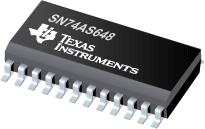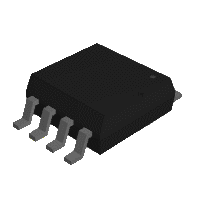●These devices consist of bus-transceiver circuits with 3-state or open-collector outputs, D-type flip-flops, and control circuitry arranged for multiplexed transmission of data directly from the data bus or from the internal storage registers. Data on the A or B bus is clocked into the registers on the low-to-high transition of the appropriate clock (CLKAB or CLKBA) input. Figure 1 illustrates the four fundamental bus-management functions that can be performed with the octal bus transceivers and registers.
●Output-enable () and direction-control (DIR) inputs control the transceiver functions. In the transceiver mode, data present at the high-impedance port may be stored in either or both registers.
●The select-control (SAB and SBA) inputs can multiplex stored and real-time (transparent mode)
●data. The circuitry used for select control eliminates the typical decoding glitch that occurs in a multiplexer during the transition between stored and real-time data. DIR determines which bus receives data when is low. In the isolation mode ( high), A data may be stored in one register and/or B data may be stored in the other register.
●When an output function is disabled, the input function is still enabled and can be used to store and transmit data. Only one of the two buses, A or B, may be driven at a time.
●The -1 version of the SN74ALS646A is identical to the standard version, except that the recommended maximum IOL in the -1 version is increased to 48 mA. There are no -1 versions of the SN54ALS646, SN54ALS648, or SN74ALS648A.
●The SN54ALS646, SN54ALS648, and SN54AS646 are characterized for operation over the full military temperature range of -55°C to 125°C. The SN74ALS646A, SN74ALS648A, SN74AS646, and SN74AS648 are characterized for operation from 0°C to 70°C.
● Independent Registers for A and B Buses
● Multiplexed Real-Time and Stored Data
● Choice of True or Inverting Data Paths
● Choice of 3-State or Open-Collector Outputs
● Package Options Include Plastic Small-Outline (DW) Packages, Ceramic Chip Carriers (FK), and Standard Plastic (NT) and Ceramic (JT) 300-mil DIPs



